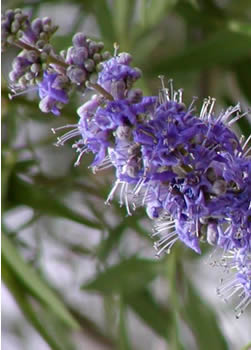
What is Vitex?
Vitex is a plant found in Asia and in Mediterranean countries. The part used medicinally is the dried fruit. Other names for it include Vitex agnus castus, Agnus castus, chaste tree, and monk's pepper.
Why People Use Vitex
Vitex was used as a traditional folk remedy for a range of female conditions, such as post-partum hemorrhage and to help with the "passing of afterbirth". One of its alternate names, "chaste tree", comes from the historical belief that it can suppress libido.
An article in March 2011's issue of "Journal of Psychosomatic Obstetrics and Gynaecology" reports that in four different studies involving a total of approximately 500 women, vitex was more effective for PMS than a placebo.
Studies are beginning to show that chasteberry may help women who have low progesterone. But chasteberry doesn't work quickly. It may take up to 7 months of consistent use to see results.
Vitex does not actually contain hormones. It appears to increase progesterone by stimulating the release of a hormone called luteinizing hormone from the pituitary gland. Vitex is also thought to normalize excessive prolactin levels and promote fertility.
- Female infertility
- PMS, especially breast tenderness, cramping, and headaches
- Acne, especially if it is related to the menstrual cycle
- Fibrocystic breast disease
- Heavy menstruation
- Menopausal symptoms
Dosage
Experts recommend taking 40 mg/day first thing in the morning or 20 mg twice daily.
Side Effects and Safety Concerns
More common side effects include mild digestive upset or skin rash. Other side effects may include rapid heartbeat, hair loss, headache, dry mouth, nausea, rash, itching and bleeding between periods.
Vitex is not recommended during pregnancy. It shouldn't be used by nursing women unless under the guidance of a qualified health professional.
People with hormone dependent conditions such as endometriosis, uterine fibroids, and cancers of the breast, ovaries, uterus or prostate shouldn't take vitex.
Small amounts of vitex could increase the production of breast milk in post-partum women. High doses may have the opposite effect and decrease the production of breast milk.
Vitex may affect levels of the neurotransmitter dopamine. People with Parkinson's disease, schizophrenia, or any other condition in which dopamine levels are affected should avoid vitex unless under the supervision of a qualified health professional.
Possible Interactions
Vitex may decrease the effectiveness of oral contraceptives or female hormone replacement. It could also theoretically increase the risk of side effects.
Vitex could interfere with the effectiveness of drugs that increase dopamine, such as bromocriptine, cabergoline, carbidopa-levodopa, Mirapex or Requip, or decrease dopamine, such as chlorpromazine, clozapine (Clozaril), haloperidol (Haldol), metoclopramide (Reglan), Risperdal, Seroquel, thioridazine, trifluoperazine or Zyprexa.
Sources: WebMD, About Alternative Medicine
 Acne.org Products
Acne.org Products